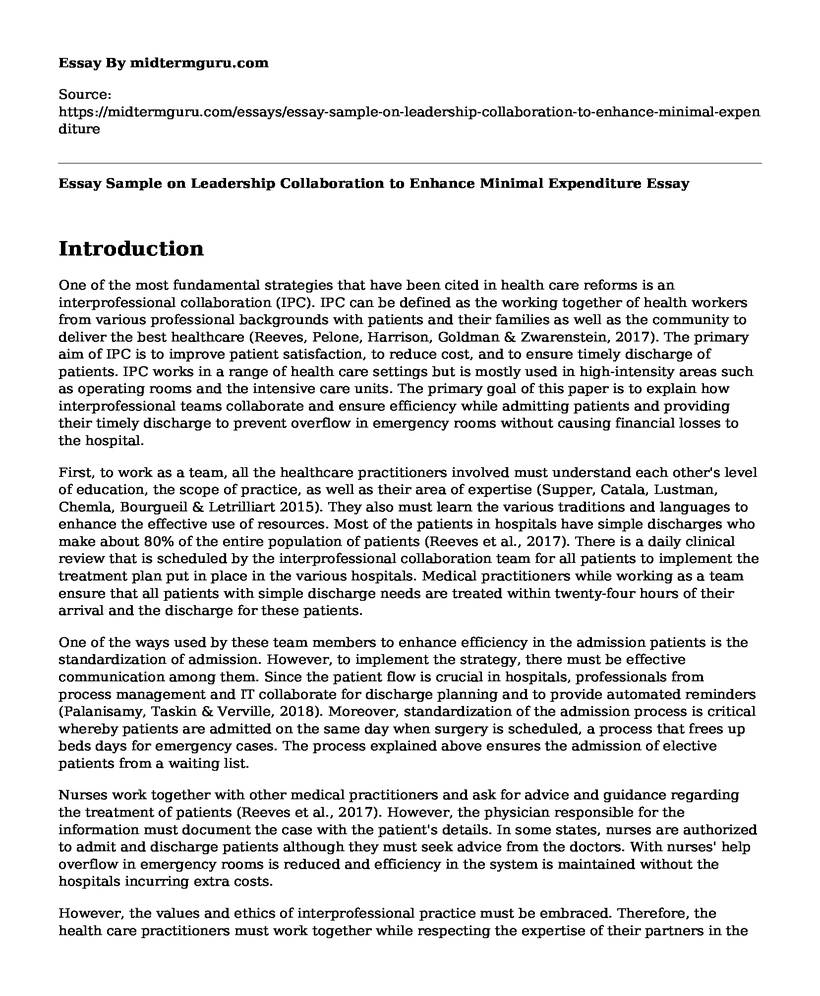Introduction
One of the most fundamental strategies that have been cited in health care reforms is an interprofessional collaboration (IPC). IPC can be defined as the working together of health workers from various professional backgrounds with patients and their families as well as the community to deliver the best healthcare (Reeves, Pelone, Harrison, Goldman & Zwarenstein, 2017). The primary aim of IPC is to improve patient satisfaction, to reduce cost, and to ensure timely discharge of patients. IPC works in a range of health care settings but is mostly used in high-intensity areas such as operating rooms and the intensive care units. The primary goal of this paper is to explain how interprofessional teams collaborate and ensure efficiency while admitting patients and providing their timely discharge to prevent overflow in emergency rooms without causing financial losses to the hospital.
First, to work as a team, all the healthcare practitioners involved must understand each other's level of education, the scope of practice, as well as their area of expertise (Supper, Catala, Lustman, Chemla, Bourgueil & Letrilliart 2015). They also must learn the various traditions and languages to enhance the effective use of resources. Most of the patients in hospitals have simple discharges who make about 80% of the entire population of patients (Reeves et al., 2017). There is a daily clinical review that is scheduled by the interprofessional collaboration team for all patients to implement the treatment plan put in place in the various hospitals. Medical practitioners while working as a team ensure that all patients with simple discharge needs are treated within twenty-four hours of their arrival and the discharge for these patients.
One of the ways used by these team members to enhance efficiency in the admission patients is the standardization of admission. However, to implement the strategy, there must be effective communication among them. Since the patient flow is crucial in hospitals, professionals from process management and IT collaborate for discharge planning and to provide automated reminders (Palanisamy, Taskin & Verville, 2018). Moreover, standardization of the admission process is critical whereby patients are admitted on the same day when surgery is scheduled, a process that frees up beds days for emergency cases. The process explained above ensures the admission of elective patients from a waiting list.
Nurses work together with other medical practitioners and ask for advice and guidance regarding the treatment of patients (Reeves et al., 2017). However, the physician responsible for the information must document the case with the patient's details. In some states, nurses are authorized to admit and discharge patients although they must seek advice from the doctors. With nurses' help overflow in emergency rooms is reduced and efficiency in the system is maintained without the hospitals incurring extra costs.
However, the values and ethics of interprofessional practice must be embraced. Therefore, the health care practitioners must work together while respecting the expertise of their partners in the other disciplines (Supper et al., 2015). Furthermore, they have to be aware of the responsibilities of their fellow team members, have effective communication with patients and their families as well as building strong relationships to plan, implement, and evaluate self-care of patients.
Conclusion
In conclusion, IPC has several benefits which include improved patient outcomes; fewer errors are made, reduced healthcare costs, and the enhancement of relationships among people of different professions. With good communication, workloads for all professionals is decreased, and their duplication effort is minimized too. A better understanding is also created. When the team members collaborate to admit and discharge patients, the emergency rooms are available for incoming patients. Therefore, sufficient room is created to accommodate more severe cases.
References
Palanisamy, R., Taskin, N., & Verville, J. (2018). Impact of trust and technology on interprofessional collaboration in healthcare settings: An empirical analysis. In Health Care Delivery and Clinical Science: Concepts, Methodologies, Tools, and Applications (pp. 1325-1364). IGI Global.
Reeves, S., Pelone, F., Harrison, R., Goldman, J., & Zwarenstein, M. (2017). Interprofessional collaboration to improve professional practice and healthcare outcomes. The Cochrane Library.
Supper, I., Catala, O., Lustman, M., Chemla, C., Bourgueil, Y., & Letrilliart, L. (2015). Interprofessional collaboration in primary health care: a review of facilitators and barriers perceived by involved actors. Journal of Public Health, 37(4), 716-727.
Cite this page
Essay Sample on Leadership Collaboration to Enhance Minimal Expenditure. (2022, Oct 23). Retrieved from https://midtermguru.com/essays/essay-sample-on-leadership-collaboration-to-enhance-minimal-expenditure
If you are the original author of this essay and no longer wish to have it published on the midtermguru.com website, please click below to request its removal:
- Business Ethics Class - Essay Example
- Essay on Advantages and Disadvantages of Flextime
- Essay on Leadership as One of the Aspects of the Development of Effective Learning Institutions
- Essay on Qualities of an Educational Leader
- Cultural Qualities and CSR: Exploring Sao Paulo, Brazil and Shenzhen, China - Essay Sample
- Organizational Ethics: Key Considerations for Decision Making - Essay Sample
- Attracting and Retaining Top Talent: The Power of Incentives - Essay Sample







